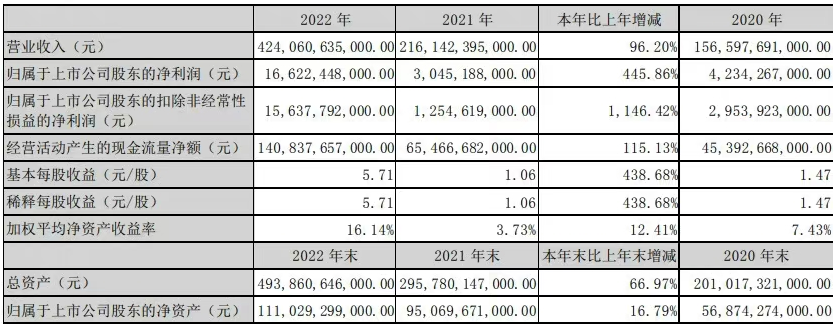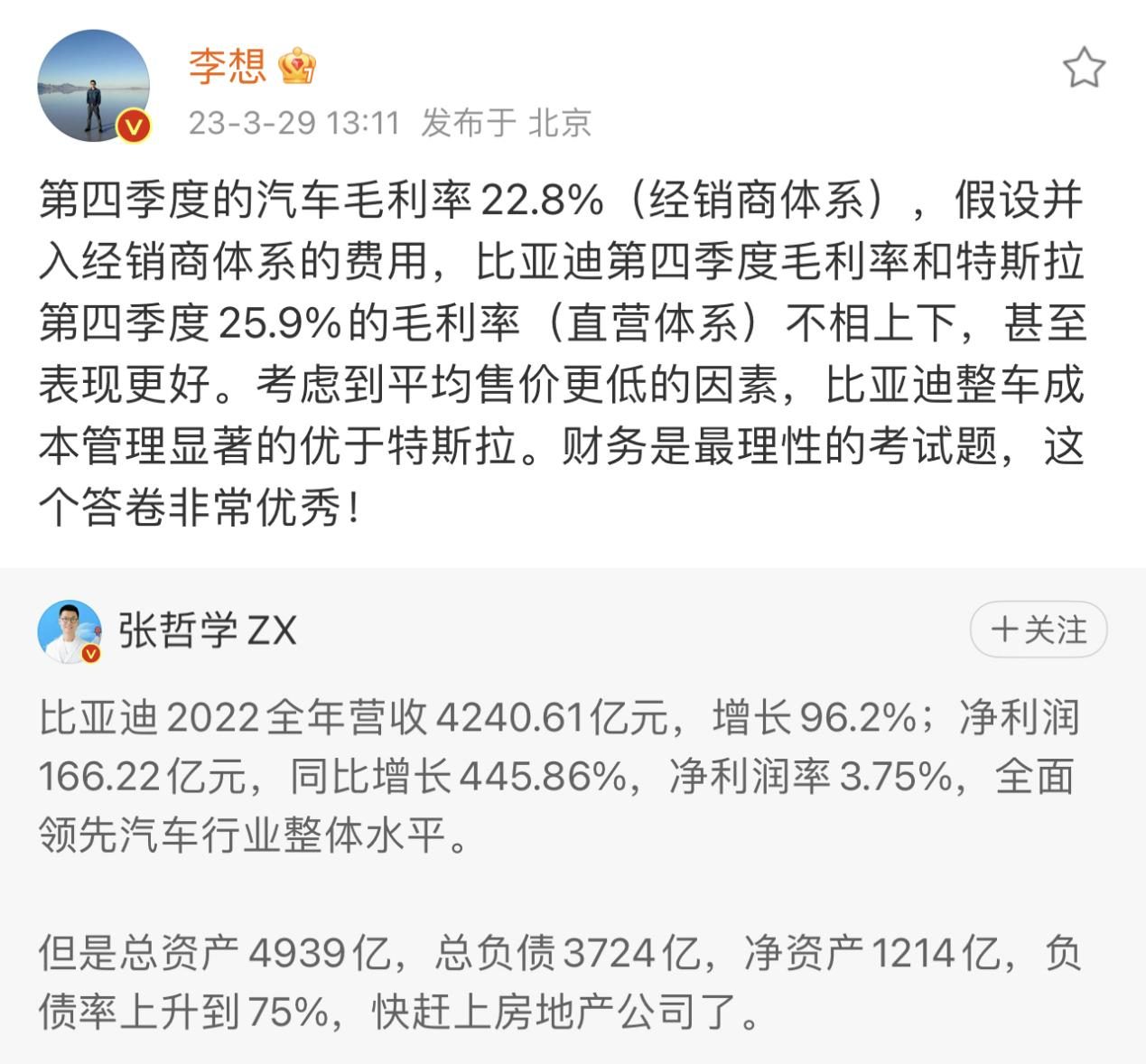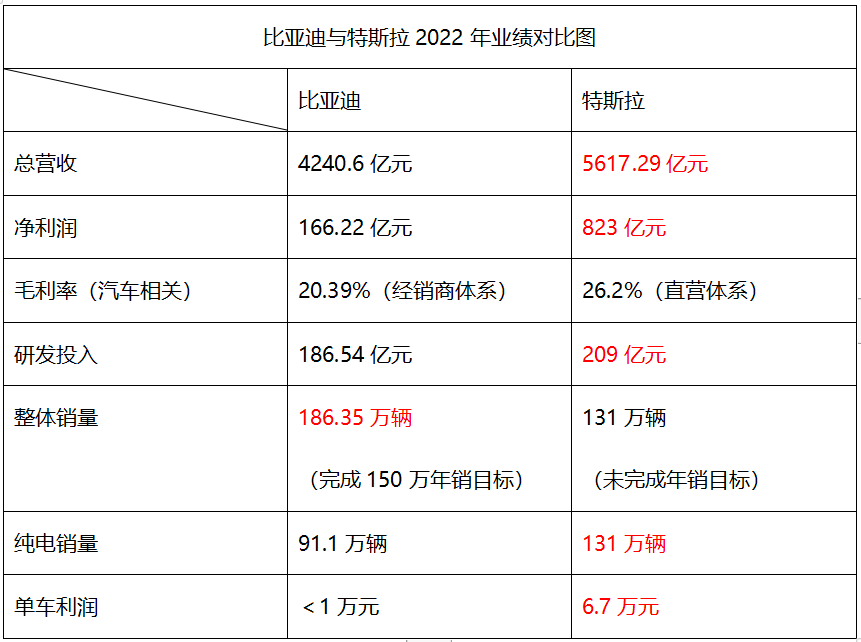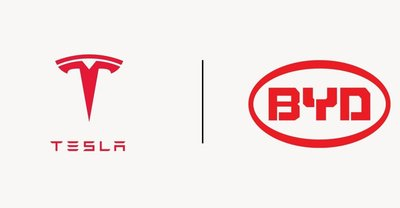Author | Zhang Ruichen
Editor | Pan Tan
Recently, BYD released its 2022 financial report, which is the best performance in its history since announcing the cessation of production and sales of fossil fuel vehicles and transitioning towards new energy.
The financial report shows that BYD achieved revenues of CNY 424.06 billion in 2022, an increase of 96.20% year-on-year; net profits attributable to the parent company reached CNY 16.622 billion, an increase of 445.86%; net cash flows generated from operating activities amounted to CNY 140.838 billion, an increase of 115.13%. Net profit after deducting nonrecurring gains and losses attributable to the parent company was CNY 15.638 billion, with a year-on-year growth of 1,146.42%.
Of BYD’s CNY 424.06 billion revenue in 2022, the income from automobile-related products and other business sectors was about CNY 324.69 billion, a year-on-year increase of 151.78%; the income for mobile phone components, assembly and other product businesses other than automobiles amounted to CNY 98.815 billion, a growth of 14.3%. The two sectors made up 76.57% and 23.30% of BYD’s total revenue, respectively.
In 2022, BYD surpassed Tesla to reclaim the title of global new energy vehicle (including pure electric and hybrid) sales champion. Moreover, BYD became the first Chinese automotive brand to achieve both the milestone of selling one million new energy vehicles in a year and rolling off the production line of the three millionth new energy vehicle.

Higher sales volume and higher profit per vehicle
In 2022, BYD’s accumulated production of new energy vehicles reached 1.877 million units, a year-on-year increase of 209.17%. The cumulative sales of new energy vehicles totaled 1.8635 million units, up by 208.64%.
According to data released by the China Association of Automobile Manufacturers in 2022, BYD’s new energy vehicles already account for more than 27% of the total market share, an increase of nearly 10 percentage points compared to 2021. This means that in 2022, one out of every four new energy vehicles sold was a BYD.
Looking at the performance of BYD’s specific models, the company launched several popular and high-volume models in 2022, such as the Seal, Yuan PLUS, the upgraded Han family, and Tang DM-p, etc. The Seal, which only started deliveries in August, broke through 50,000 units in annual sales last year, and exceeded 15,000 units in December alone. With three consecutive months of sales over 10,000 units, it has undoubtedly become BYD’s current new bestseller. In addition, the Han and Tang families, the darlings of the Dynasty series, have steadily output impressive results, securing the top position with over 270,000 units and 150,000 units respectively. Even if looking at BYD’s Han family alone, its sales volume is higher than many emerging automakers’ overall sales.After discussing the overall picture, let’s examine BYD’s sales and profits on a quarterly basis.
In 2022, BYD’s sales per quarter were 286,000, 355,000, 539,000, and 683,500 units, with profits of 800 million, 2.8 billion, 5.7 billion, and 7.3 billion, respectively. The per-unit profits for each quarter were 2,400, 7,000, 9,500, and 9,800 yuan, indicating that both sales and profits were gradually increasing, which was largely related to BYD’s two price hikes last year.
Due to the long delivery cycle of BYD’s new vehicles and the large number of orders after the price increase, more deliveries occurred in the third and fourth quarters, which drove up per-unit profits. In other words, this ladder-like growth trend in net profit is basically in line with BYD’s sales growth.
BYD vs. Tesla: Who is the King?
The positive growth in both sales and profits allowed BYD to achieve an overall gross margin of 17.04% in 2022, an increase of more than 4 percentage points compared to 2021. Among them, the gross margin of automotive-related products reached 20.39%, a year-on-year increase of about 3.7 percentage points. Li Xiang, CEO of Ideal Automotive, also shared his thoughts on BYD’s 2022 financial results on his personal social media.

Since Li mentioned that BYD’s performance could be even better than Tesla’s, let’s take a look at the comparison between BYD and Tesla.
As Li Xiang pointed out, BYD’s gross margin includes its dealer system. If the dealer system’s costs are included, BYD’s annual gross margin for 2022 could likely surpass Tesla’s. Other data such as net profit, R&D investment, and sales are shown in the table below:
 Although Tesla’s overall sales are not as strong as BYD’s, its net profit and profit per vehicle are much higher than BYD’s, which means it makes more money. This is why Tesla has a market value of $620 billion (approximately 4.26 trillion RMB), while BYD’s market value is around 750 billion RMB, the former being more than five times higher than the latter.
Although Tesla’s overall sales are not as strong as BYD’s, its net profit and profit per vehicle are much higher than BYD’s, which means it makes more money. This is why Tesla has a market value of $620 billion (approximately 4.26 trillion RMB), while BYD’s market value is around 750 billion RMB, the former being more than five times higher than the latter.
Moreover, there have been reports that BYD’s sales target for 2023 will be set at 4 million units, but BYD has not yet confirmed this and states that it is difficult to estimate. Given the company’s delivery of 344,996 units in the first two months of 2023 and the hundreds of thousands of undelivered new vehicle orders in BYD’s hands, reaching an annual sales volume of over 3 million units should be achievable, so aiming for 4 million units is not an impossibility.
In Conclusion:
BYD’s official interpretation of its sales performance is: “The rapid growth of new energy vehicle sales has not only driven a significant improvement in profitability but also mitigated the cost pressures brought about by rising upstream raw material prices.” So, with improved profitability, will BYD consider lowering prices for its models that previously experienced price increases due to cost issues?
In summary, BYD’s performance in 2022 can be described as rapid and unexpected. Currently, BYD has clearly established its own business model in the new energy vehicle industry, overcome the phase of prioritizing market presence over profitability, and become one of the few Chinese new energy vehicle companies to achieve large-scale profitability.
This article is a translation by ChatGPT of a Chinese report from 42HOW. If you have any questions about it, please email bd@42how.com.
